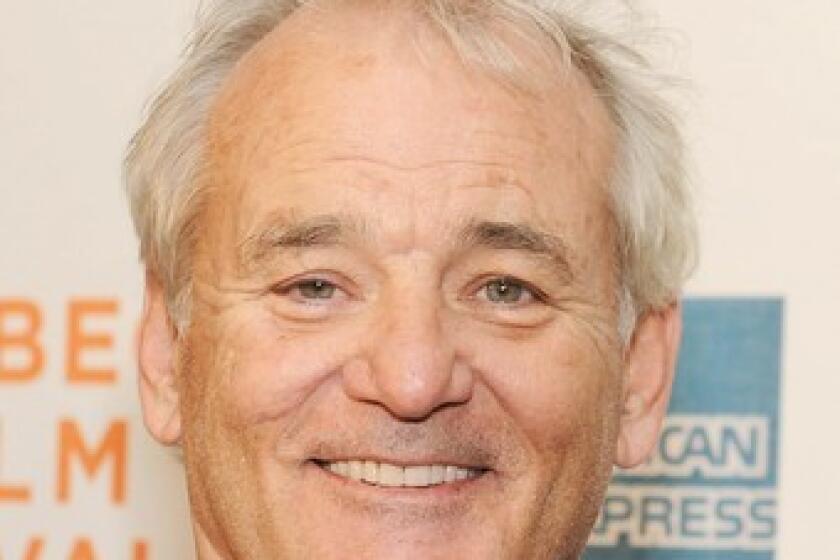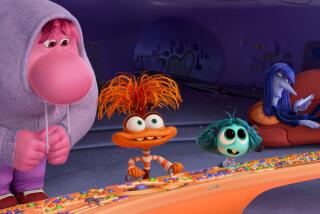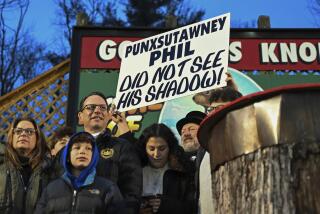Column: Let’s honor Groundhog Day like it’s ‘Groundhog Day.’ Revisiting the movie amid COVID-19
- Share via
Here’s an idea: Let’s honor Groundhog Day like it’s “Groundhog Day.”
The 1993 movie, in which a bratty TV weather announcer gets trapped in an endless repeating loop of Feb. 2, has become the cultural totem for this pandemic year. Like Bill Murray’s Phil Connors, billions of the world’s citizens are in a place they do not want to be, forced by COVID-19 into constricted versions of daily life that can be downright maddening in their endless repetition.
Or, as my 14-year-old just said, “Guess who just had a mental breakdown this morning because she cannot face doing the same exact thing every single day?”
Actually she sang it, because in our family, we have been keeping madness at bay by pretending we are all in a Stephen Sondheim musical. It’s helping.
“Groundhog Day” also relied heavily on music — the opening strains of Sonny and Cher’s “I Got You Babe” that famously acted as Phil’s alarm clock each and every morning before giving way to the announcement that it was, yet again, Feb. 2. A day that would see the trapped TV weather announcer once again fulfilling his most loathed assignment: to cover the appearance of Punxsutawney Phil, the titular Pennsylvania rodent who, by the state of his shadow, predicts how much longer winter shall endure.
All eyes will certainly be on Phil this year, though the festivities in Punxsutawney will be, like so much else, virtual (and, with a major snowstorm blanketing the Northeast, possibly delayed). Everyone wants this winter, with its post-holiday coronavirus surges, early fumbling of vaccination distribution and the emergence of several new COVID strains, to end early.
“Early” as in “right now.” And if all it takes to turn things around is a groundhog’s shadow, well, bust out the snow shovels and the sunlamp.
“Groundhog Day” may not be the funniest collaboration between Bill Murray and director Harold Ramis, and it doesn’t have a chance of being the most financially successful.
But shadow or not, those of us fortunate enough to not suffer directly from the coronavirus — through physical ailment, grievous loss or front-line engagement — will continue to tread the well-worn paths of our socially distant days, wondering if it’s safe to get our teeth cleaned again and marveling at how exciting a trip to the dentist has become.
As in “Groundhog Day,” time has become ... if not moot, then certainly relative. Our orbits are not, like Phil’s, limited to a single day, but without the social events and shared rituals that previously shaped our calendars, it can feel that way.
Days blur into weeks, weeks smudge into months, and suddenly it seems a year is gone, marked not so much by our personal guideposts as by those national and international events that made enough noise to cut through the billowing miasma of brain fog. The deaths, the shutdowns, the surges, the mask wars; the BLM protests, the presidential election, more deaths, the insurrection, the vaccinations.
I seem to remember Los Angeles doing well in the NBA finals and the World Series last year, and that everyone loved “The Queen’s Gambit.” Many people of my acquaintance are currently mourning the in-person delights of Sundance (although summoning a large group of people not known for their physical heartiness to a very cold place for the purposes of crowding them together in overheated venues during the height of cold and flu season now seems completely insane).
But while I can still name more counties in Pennsylvania and Georgia than I have any right to know, I really could not give you an accurate account of my life last week, much less last month. It rained a bit I think, and GameStop somehow destroyed Wall Street. But all my kids are still living at home and frankly, it takes whatever energy I have left over from work just to keep the refrigerator stocked (and to hide a few tangerines in my sock drawer for later because honestly, they just vanish).
The alarm goes off, I make the same coffee, see the same people, face the same screens, take the same walks, day after day after day. “Total ‘Groundhog Day,’” I sigh, along with millions of others.
On this Feb. 2, perhaps instead of just invoking its name, we could consider the actual movie.
Bill Murray’s golf company might have used the Doobie Brothers’ hit “Listen to the Music” without proper payment. But the response was all in good fun.
Writer Danny Rubin and writer/director Harold Ramis mapped Phil’s journey by following Elizabeth Kübler-Ross’ stages of grief: denial, anger, bargaining, depression and acceptance — a journey which sounds very familiar, if particularly painful given the amount of death many of us have seen.
But in the film, “acceptance” is not the final stage, at least not in the sense of surrender. Yes, after refusing to believe what was happening, then railing against its injustice, after attempting to exploit a life without time and therefore without consequence, and then end it by his own action, Phil accepts what he cannot change. But more important, he comes to realize that there are still important choices he can make within that 24-hour cycle, choices that make “Groundhog Day” a film about growth.
He learns how to play the piano and ice-sculpt. He reads, he exercises, he enjoys nature. He may have a limited number of humans with whom to engage, but he begins to engage with each of them.
Now, in case you think this is yet another piece promoting all the cool things we should have (and still can!) accomplish during a pandemic, it’s not. Many of us faced early lockdown with grandiose visions of learning French or how to quilt, of writing that play or finally toning those upper arms. And perhaps some people did achieve those kinds of goals, and if you are one of them, please, for the love of God, keep it to yourself.
The rest of us made good starts but then, you know, both the dishwasher and the clothes dryer broke (possibly because each was being run every single day) and the people who usually fixed them were booked for months (possibly because nothing is harder on home appliances than a stay-at-home order). After three months of washing every dish by hand and hanging out everything to dry, some of us simply did not have the energy to learn how to quilt. And flabby upper arms are why sleeves were invented.
No, this is about the more general theme of “Groundhog Day,” which is “whenever possible, be nicer to people.” Murray’s Phil is a jerk in the beginning of the film because he doesn’t see the point in being nice — too much effort for too small a payoff.
During the course of the film, however, he learns that being nice can change your world. But, like playing the piano, it takes practice. To really learn something, you have to do it over and over again.
Punxsutawney Phil will look for his shadow on Broadway starting in 2017.
So in my own version of “Groundhog Day,” I have not become fluent in French, but I have learned more patience than I ever thought possible in a person of my general temperament. My cupboards are still cluttered but after months of thinking my kids will be back to school and life back to normal by [fill in the blank], I have learned to manage my expectations. I mourn the things I have missed and still miss, but every day that passes without a friend or family member falling ill or dying reminds me how fortunate I am, and prods me to give what I can to those who are not.
The point of “Groundhog Day” does not lie in the hilarity of watching Murray fight against his fate but rather in his character’s learning that his is not the only fate that matters. All those people he treated like his personal wallpaper are, in fact, people, and only when he recognizes that their needs are as important as his own is he able to actually move forward.
So, as Phil Connors heard about 1,001 too many times, “OK, campers, rise and shine — it’s Groundhog Day!”
More to Read
Only good movies
Get the Indie Focus newsletter, Mark Olsen's weekly guide to the world of cinema.
You may occasionally receive promotional content from the Los Angeles Times.












